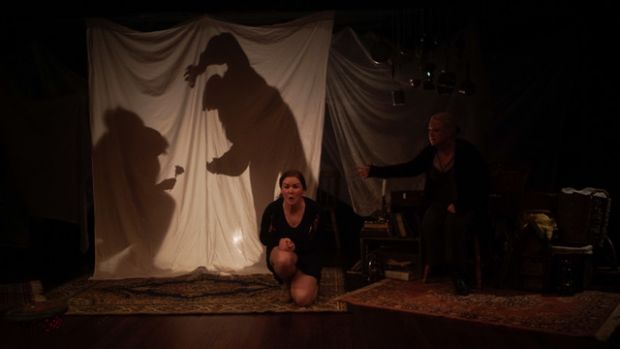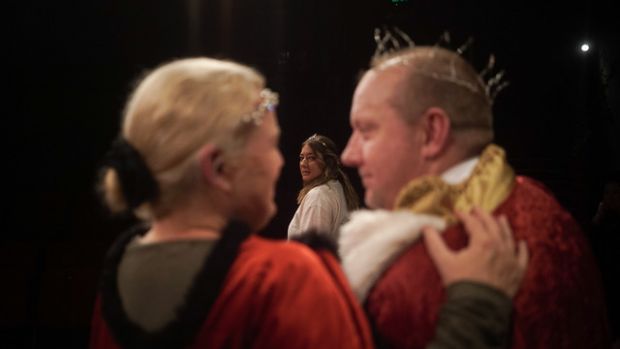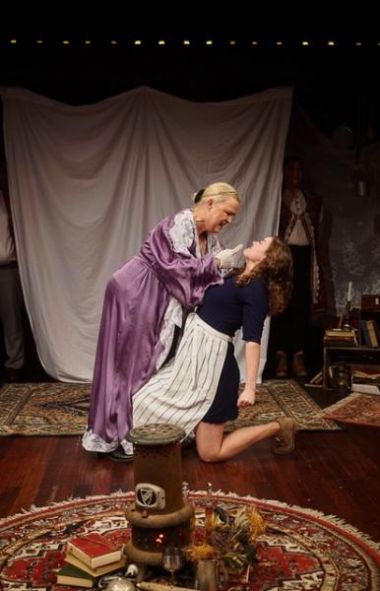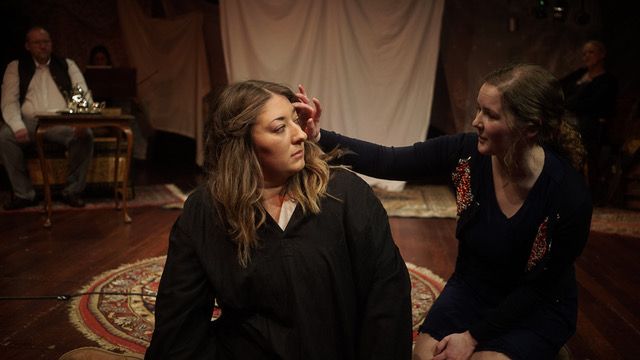Kissing the Witch
Kissing the Witch was written by acclaimed Irish author and playwright Emma Donoghue, best known for her novel Room. It is reminiscent of act two of the iconic musical Into the Woods, but with a feminist perspective.
Donoghue writes from a lesbian feminist perspective about things that aren’t what they appear to be, finding yourself, finding your identity and finding your voice.
Her mixed bag of five tales is framed by the presence of three performers who in turn each take the role of a girl whose answered prayers invariably invoke that homily “Be careful what you wish for”. The three witches from Shakespeare’s immortal Macbeth kept popping into my mind.

‘The Tale of the Rose’ is based on Beauty and the Beast in which Rose forfeits her freedom to save her father; her captor, however, turns out not a Prince in beastly guise, but rather a Queen offering domestic-partnership.
Next, ‘The Tale of the Handkerchief’ based on the Grimm’s’folk tale of The Goose Girl who yearns for adventure beyond pampered palace life, but gets more than she bargained for as her grief-addled widower father’s incestuous unwelcome advances force her to run to the unpleasant real world.
‘The Tale of the Skin’ is based on the Grimm’s folk tale of Donkeyskin involving an envious servant who steals a princess’s identity only to find the pleasures of palace life boring, but fear of exposure leaves her feeling more trapped than ever; the real princess, conversely, finds happiness as a shepherdess.
‘The Tale of the Voice’ is based on Hans Andersen’s Little Mermaid. Smitten with a handsome traveller, a fisherman’s daughter begs for “strange magic” that will catch his eye. That it does — but being used, abused and cheated on as his plaything wasn’t the happy ending she had in mind.

A final segment ‘The Tale of the Kiss’, not based on any source text, but suggested by various folk motifs about oracles and magic helpers, tells how one woman came to be a “witch”. Seeking “a life of my own”, she accepts both the independence and loneliness of a forest-dwelling witch until fate brings her a mate, another unhappy girl much like her younger self.
Kissing the Witch relies heavily on each successive protagonist to “tell” her own story and Director Imogen Deller-Evans has chosen her cast wisely. There is a pleasing variation of youth and experience in the cast who gel together as a tight unit.
Deller-Evans utilizes the in-the-round setting of the Little Theatre perfectly and the movement from tale to tale is seamless.

Thomas Brogden’s Wicca inspired setting with its lace tablecloths, herbs, baskets and central fire adds to the folk-tale nature of the play as does Stephen Dean’s moody evocative lighting and Yolanda Tree’s quirky collection of costumes that have just the right ‘dress-up’ quality for telling folk tales.
Special mention should be made of Helen Morriss’ musical contribution. Her violin underscoring was sensitive, never dominating and added to the atmosphere of the production.
The three female performers – Susan Cilento (Rose, the Goose Girl, the fisherman’s daughter), Michelle Hrvatin (the witch, the jealous servant in The Tale of the Skin), and Ellie-May Enright (the witch from the last tale and the beast) give balanced performances and shine in their own stories. My personal favourite characters are Enright’s Beast and the witch from the last tale. Enright is able to take us to the soul of each character.
Sam Wiseman‘s MAN gives us what men are often in fairy tales - silly, senseless things, when not cruel predators, and fosters the idea expressed by some men, “When a boy changes his life, it’s called an adventure, when a girl does the same, it’s only a fairy tale.”.
I must admit to not being a fan of actors inhabiting ‘the space’ before the start of the production. There are exceptions where this interplay adds to the understanding of the upcoming text or adds a specific mood. I understand the director’s intent here, but for me, as an audience member, it did not work.

Other productions of this play have included an interval between tales three and four, I wondered why this one did not? A break after tale three would have allowed the audience to decompress, debrief with friends and return to the play with fresh perspectives.
Kissing the Witch is an interesting take on traditional fairy tales and the way we view stereotypes. Both serious and comedic, it questions identity and true love. It also provides lots of room for critical thinking, not only about the notion of who we are, but the tales that are ingrained in our culture and what they really mean.
Barry Hill OAM
Subscribe to our E-Newsletter, buy our latest print edition or find a Performing Arts book at Book Nook.

